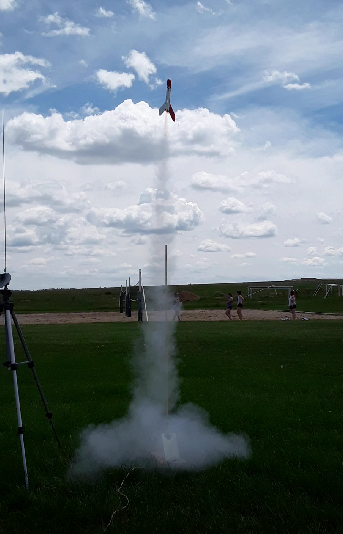Excellent weather prevailed as a small group of Colorado rocketeers converged on Dove Valley park in Centennial for another of our vaunted launch sessions. Jim Gazur and Roy Houchin joined me at around ten a.m. to find we had the large, well-manicured grass field to ourselves. A light south-west breeze and temperature in the low 70s was the order of the day.
I started things off with a launch of the EAC Viper clone on A10 power. The flight was good, but suffered yet another 'parawad', resulting in one fin breaking loose on the hard landing.
My third flight of the day went to the newly-built Cherokee-E. Not wanting to fly this bird on E power in this relatively small field, I chose to go with a D12-5 instead. Good call...
The model boosted much higher than expected, popped its 14" parachute, and began a very slow descent. With the presence of some slight wind and thermal activity aloft, I knew this one was going to be a chase.
A quarter mile trek and a journey through waist-high weeds later, I found the Cherokee.
Unusual recovery case #2:
The model had landed on a stream! Not in- but on. The waterway was about 2- 1/2 feet wide and flowing about a foot deep. The Cherokee's shock cord spanned the stream with the parachute and nose on one bank and the booster rocket on the other. One fin was in the water. If the parachute had drifted another six inches, the rocket would have been submerged and likely ruined.
Phew! That was way too close.
I returned back to the launch area in time to see this model launched by Roy:
This is a Modified (i.e. "Frankenstein") Estes Flip Flier. This one boosted on a C6-3 motor, weather-cocked, arced over, and pranged on the grass berm just south of the launch area. Roy went on recovery and came back - beaming - holding the intact model. No damage whatsoever! Unusual recovery case #3!
So, what has Jim Gazur been doing this whole time?
Here's a hint....
This Estes 1/45 scale Little Joe II is equipped with a 7 motor cluster.
Yep - 7. A core C11-3 surrounded by six A10-0T motors populating the scale nozzles. To compensate for the additional weight in the tail, Jim had installed a tungsten nose weight. The cluster was ignited using vintage Quest Q2G2s.
With all motors burning, the model lifted off very quickly (and majestically!). Flying straight up, the Little Joe exhibited a visible 'kick in the pants' when the six A10s burned out and exited.
The model continued to altitude where the parachute blossomed out and brought it safely down to Terra Firma.
This was by far the most beautiful flight of the day. Kudos to Mr. Gazur for successfully pulling this one off!
Next up, I prepped my little custom boost/glider, the Mini-Maggot 3, for flight on a 1/2A motor. I figured it would be fine to fly this small, low-powered bird on this big field.
Wrong!
I failed to remember the breeze and thermals that caused the Cherokee-E to sail away just a half hour earlier. I also failed to recall my habit of losing gliders to Dove Valley...
Nevertheless, the MM3 flew, boosting straight up and separating perfectly. The glider immediately settled into its signature tight-turned pattern...and caught a thermal!
Another chase was on as the bird headed north.
After reaching the top of the grass berm at the north end of the field, I spotted the downed glider - smack-dab in the middle of a six lane thoroughfare!
Unusual recovery case #4...
The glider had landed right on one of the lane lines, and to my horror I had to watch helplessly as half a dozen automobiles bore down on it.
The vehicles raced by on either side, just inches from the little glider. For some odd reason I was reminded of the old 'Frogger' video game.
After the cars had passed, I had time to step out into the road, photograph the glider, and facilitate its rescue.
I returned to the launch area in time to watch Roy's final flight of the day, an Estes Skywinder. Flying on C6-3 power, the model turned in a great flight.
My last flight of the day went to the Mark II Rock-A-Chute clone, again launched from a 5/16 wood dowel launcher. The model flew nicely on A10 power. I had decided to stick with a bird that wouldn't go too far this time. The Mark II 'para-wadded', landing in the soft sand of a nearby volleyball court with no damage.
Jim Gazur launched the last rocket of the session, his Avionics Test Bed model, flying on a Quest Q-jet D20-4W.
Topping out at a little over 200 feet, the model's dual deploy system worked perfectly. Jim wanted a low-altitude flight so he could get a better visual of the recovery deployment system. The rocket also carried an Estes Astrocam video unit to get an on-board look at the process.
Unusual recovery case #5:
Jim's model wafted down on its parachute only to drape itself over one of the nearby volleyball nets! It took him several minutes to extract the bird from the clutches of the obstacle.
With that done, we packed up the gear and exited the field, vowing to meet here again in the near future.






















